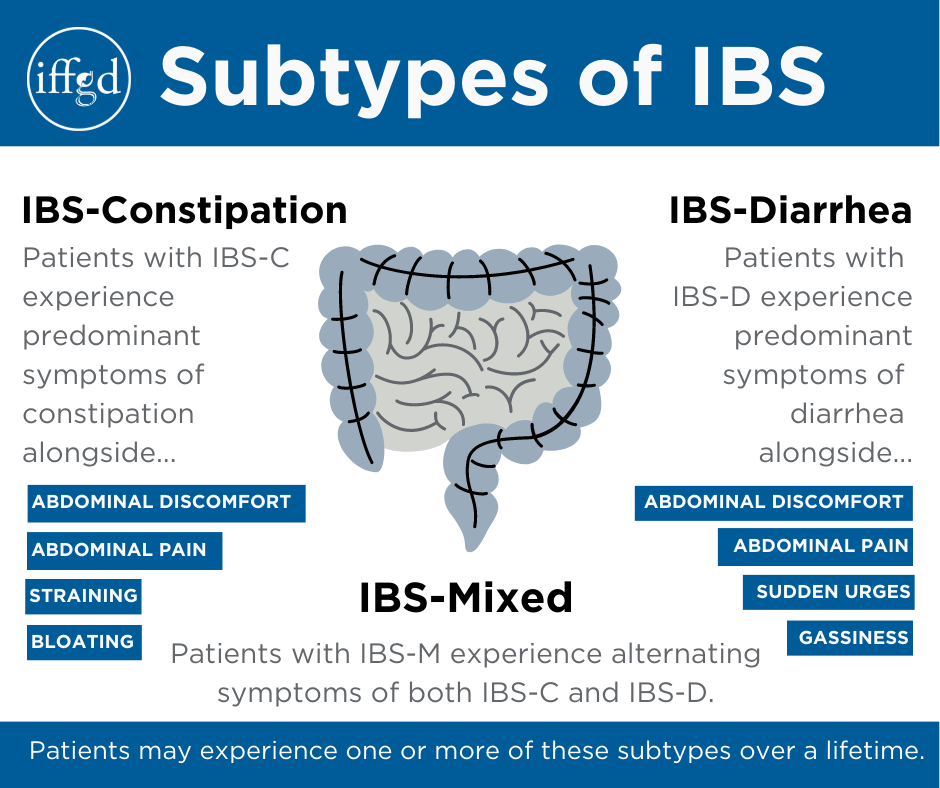IBS is often categorized based on the most common type of bowel movements experienced. These subtypes include:
- Irritable bowel syndrome with diarrhea (IBS-D)
- Irritable bowel syndrome with constipation (IBS-C)
- Irritable bowel syndrome mixed (IBS-M)
Identifying the subtypes of IBS is helpful when deciding which tests and/or treatments are best.

IBS with diarrhea (IBS-D)
Diarrhea is one of the symptoms often associated with irritable bowel syndrome (IBS). Most people define diarrhea as loose stools or watery stools. Others think of diarrhea as frequent bowel movements.
The key symptom of IBS is abdominal pain. The pain is associated with a change in the frequency or consistency of stool. Some people have both diarrhea and constipation, just at different times. Bloating or distention in the abdomen is also common.
IBS with diarrhea is sometimes referred to as IBS-D.
Learn more about diet strategies for managing chronic diarrhea
IBS in the Real World diarrhea findings
In 2002, we contacted a random sample from our IFFGD database of U.S. adults diagnosed with IBS. A total of 350 people took part in telephone interviews. The information gathered reflects the tremendous burden IBS can impose upon a large proportion of sufferers.
Those who experienced IBS with diarrhea reported having multiple symptoms. Nearly all reported…
-
- Gas
- Abdominal pain
- Sudden urges
- Loose stools
The most bothersome symptoms of IBS with diarrhea reported were…
-
- Abdominal pain or discomfort
- Sudden urges to
- have bowel movements
Other common symptoms of IBS with diarrhea were…
-
- Frequent stools
- Feeling of being unable to completely empty at bowel movements
- Nausea
Loss of bowel control or soiling was reported by about 1 in 3 of these IBS sufferers.
On average the frequency of symptoms reported by diarrhea sufferers translates to over 200 episodes a year for gas and frequent stools.
IBS with constipation (IBS-C)
Constipation means different things to different people – even doctors. Doctors usually define constipation as hard pellet-like stools. Individuals usually think of constipation as…
- infrequent stools
- difficulty or straining at stools
- feeling of being unable to completely empty during a bowel movement, or the sensation of wanting to go but not being able to.
Patients who experience constipation with IBS may also have abdominal pain as well as bloating or distention in the abdomen. Symptom occurrence can fluctuate over time, meaning there can be periods where symptoms flare-up as well as periods when they diminish or disappear.
It is also important to note that the main bowel habit can change over time. So although you primarily experience constipation, you may also have episodes of diarrhea.
There’s a Difference between IBS and Chronic Functional Constipation
People with IBS have abdominal discomfort or pain associated with their bowel habit. They may have symptoms that overlap with functional constipation. People with functional constipation may not have the abdominal pain of IBS. Or they may have less pain than with IBS. They would not have intervals of normal bowel habit and diarrhea with loose stools that can occur in IBS.
IBS with constipation is sometimes referred to as IBS-C or constipation-predominant IBS.
IBS in the Real World constipation findings
Constipation-specific symptoms were varied and frequent. The most bothersome symptoms reported were…
-
- abdominal pain,
- straining,
- infrequent stools,
- bloating and/or gas.
The constipation sufferers reported episodes of gas, bloating, and abdominal pain each as occurring on average over 200 times per year. Episodes of straining, infrequent stool, unable to completely empty, and nausea were reported as occurring between 100 to 150 times per year.
View the IBS in the Real World Survey – Summary Findings Report »
IBS mixed (IBS-M)
Those diagnosed with IBS-M experience symptoms of both IBS-C and IBS-D. These symptoms alternate and just like other subtypes can come and go over time.









